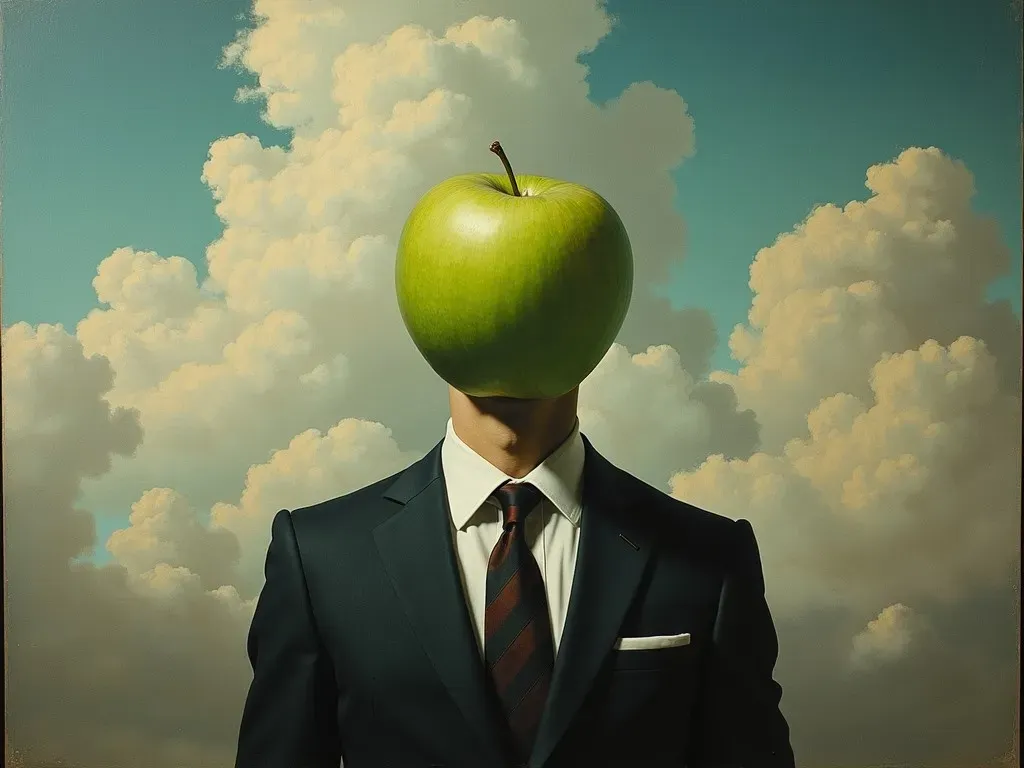The Son of Man (French: Le fils de l’homme) is a 1964 painting by the Belgian surrealist painter René Magritte. It is perhaps his best-known artwork. Magritte painted it as a self-portrait. The painting consists of a man in an overcoat and a bowler hat standing in front of a low wall, beyond which are the sea and a cloudy sky. The man’s face is largely obscured by a hovering green apple.
The Enigmatic Composition of The Son of Man
In this captivating piece, the protagonist, often interpreted as a representation of Magritte himself, poses in a seemingly mundane yet mysterious setting. His identity is deliberately obscured by the green apple, which invites viewers to consider the themes of visibility and perception. Magritte’s art often challenges viewers’ preconceived notions about reality, and The Son of Man is no exception.
Color Palette and Style
The Son of Man utilizes a muted color palette, characterized by earth tones and the brilliant green of the apple. This choice not only accentuates the central subject of the painting but also aligns with Magritte’s naturalistic style while infusing elements of surrealism.
Table: Color Analysis of The Son of Man Painting
| Color | Description | Symbolism |
|---|---|---|
| Dark Green (Apple) | Covers the face | Knowledge, temptation, obscurity |
| Earth tones | Background elements | Mundanity, reality vs illusion |
| Grey (Wall) | Ground and wall | Limitation, boundary, separation |
| Blue (Sky) | Background | Freedom, infinity |
Themes and Interpretations
The Son of Man is often viewed through various interpretive lenses. Below are some primary themes associated with the artwork:
- Identity and Concealment: The apple obscures the man’s face, suggesting that our identities can be masked or hidden from the view of others.
- Surrealism and Reality: This painting emphasizes the surreal quality of everyday life, where ordinary objects, like an apple, can take on extraordinary significance.
- Desire and Temptation: The choice of the apple can allude to the biblical figure of Adam and Eve, inviting discussions around human desires and the forbidden.
A Glimpse Behind the Canvas: The Context of The Son of Man
The painting was created in 1964, a pivotal time in Magritte’s career. It was in this period that he began to cultivate an image that retained the allure of mystery. The Son of Man was not only a self-portrait but also an exploration of how individuals present themselves to society.
Fact: The Evolution of René Magritte’s Artistic Style
- Key Periods: Transitioning from realism to surrealism in the late 1920s.
- Influences: The works of French Surrealists, particularly Salvador Dalí.
While Magritte’s contemporaries gravitated towards dreamlike scenes filled with bizarre happenings, Magritte opted for a detached, rational approach—creating art that encourages intellect-based engagement.
The Captivating Visual Elements
The man is dressed in a dark overcoat and a classic bowler hat—a motif frequently seen in Magritte’s work. These elements not only establish a sense of formality but also contribute to the portrayal of the average man. Here’s a brief list of significant visual elements:
- Bowler Hat: Represents the bourgeoisie and societal norms.
- Green Apple: Symbolizes temptation and the complexities of human nature.
- Low Wall: Divides the viewer from the horizon, suggesting limitations in perception.

FAQs About The Son of Man Painting
1. What is the meaning behind the green apple in The Son of Man?
The green apple can symbolize a variety of themes, including knowledge, temptation, and the idea of obscured identity. It is an object of desire, echoing the biblical apple and the themes of human yearning and fallibility.
2. Why is the man in a bowler hat significant?
The bowler hat is a recurring motif in Magritte’s work and symbolizes the conformity and identity of the average man, often reflecting cultural stereotypes of men in the mid-20th century.
3. How does The Son of Man fit within the surrealist movement?
Magritte’s work is unique in that it blends ordinary objects with bizarre scenarios. The Son of Man exemplifies this by placing a common fruit in an uncommonly significant location—masking the man’s face.
4. What impact has The Son of Man had on popular culture?
The Son of Man has influenced various facets of popular culture, including film, advertising, and fashion, becoming an iconic representation of Surrealism. It has prompted countless references and parodies, thus cementing its place in visual culture.
5. What are the dimensions of The Son of Man?
The painting measures 89 cm by 116 cm (approximately 35 in by 46 in).
The Legacy of The Son of Man
The Son of Man remains a staple of art education and appreciation, commanding attention for its concept and execution. It is often featured in exhibitions around the world, continuously inviting new generations to explore its layered meanings.
Through its compelling imagery and thought-provoking themes, The Son of Man continues to symbolize the complexities of identity and perception in a world filled with visual noise.
For more insights into the artwork, visit WikiArt.

Conclusion
As one stands before The Son of Man, the interplay of reality and illusion encourages a personal reflection on identity, societal roles, and the unseen complexities of human nature. In a world that often favors surface appearances, Magritte’s poignant imagery invites us to delve deeper, ultimately leaving each viewer with more questions than answers.
